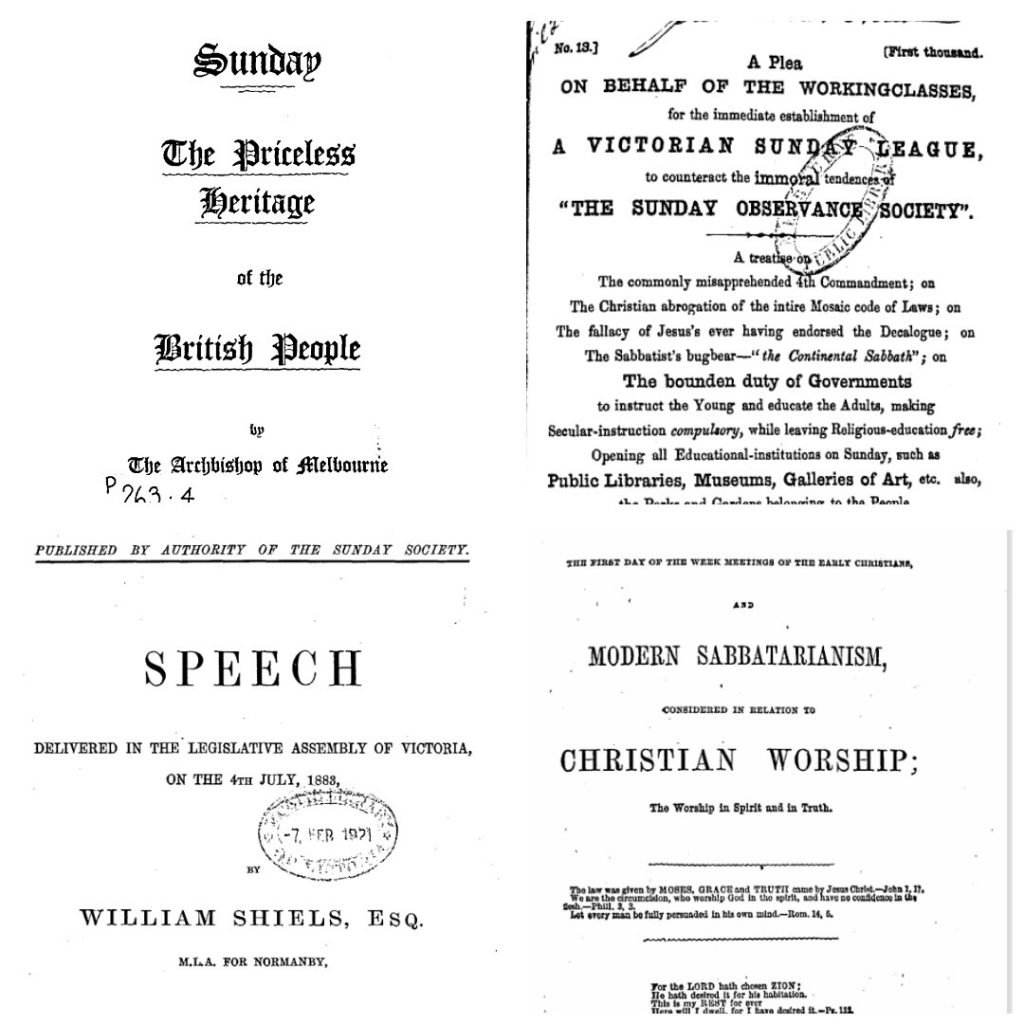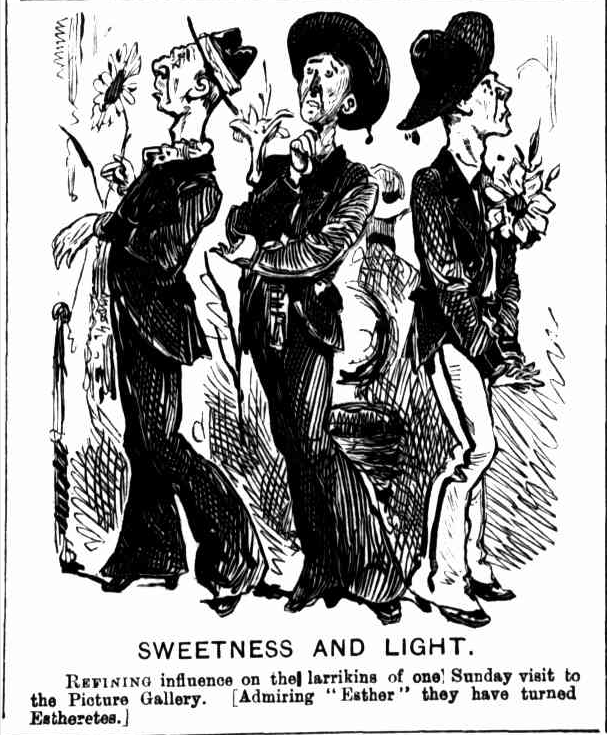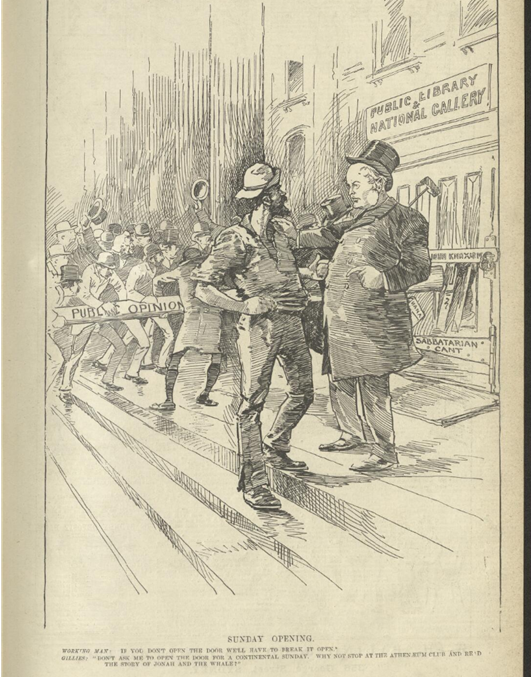Since opening in 1856, the State Library Victoria (originally known as the Melbourne Public Library) was celebrated as a place for Victorians to visit and enjoy. The question of when people could visit remained a sticking point however, particularly in relation to whether the Library should be open on Sundays. This was part of a larger debate about work and worship in Melbourne on the Christian Sabbath, which many referred to as ‘The Sunday question’.
 Detail from various pamphlets held at State Library Victoria arguing about the righteousness of Sunday activities in Melbourne (1860s-1930s) [1]
Detail from various pamphlets held at State Library Victoria arguing about the righteousness of Sunday activities in Melbourne (1860s-1930s) [1]
Disagreements over the idea of opening the Library on Sundays were related to several key points: the Christian tenet of Sabbatarianism/’Sunday Observance’ (the belief that Sundays should be kept free of labor and entertainments so as to attend church and enjoy quiet contemplation), the ability for people to access the Library (especially for workers employed Monday to Saturday, which was a common working week for many), and the question of the State Government’s willingness to pay for staff to work on Sundays.
The concept of Sabbatarianism found fertile ground throughout Victoria’s officialdom, as the Melbourne Public Library discovered when, in 1874, their request to open the Library on Sundays was rebuffed by the State Government.
 ‘The Publican of the Future,’ Melbourne Punch, December 15, 1870 p. 5.
‘The Publican of the Future,’ Melbourne Punch, December 15, 1870 p. 5.
Sunday Observance amongst politicians had ensured Melbourne’s hotels were closed on Sundays.
Within the next decade the call to open the Library on Sundays grew louder, with groups forming to argue their case: the Sunday Observance League on one hand; the Sunday Liberationists on the other. By 1883 the commentary in the press and the pulpits gathered force with the public holding large and occasionally rowdy meetings. In May 1883, the frustrated Melbourne Public Library trustees went ahead and opened the National Gallery and the museum on Sundays, knowing that they could not open the Library (much to the government’s displeasure).
The opening of the gallery and museum on Sunday afternoons was a huge success with numbers averaging over 3000 per Sunday for the few weeks they were open.
 Sunday at the National Gallery. Print published in The Australasian sketcher with pen and pencil, June 4, 1883; A/S04/06/83/105
Sunday at the National Gallery. Print published in The Australasian sketcher with pen and pencil, June 4, 1883; A/S04/06/83/105
Parliament eventually met to discuss the matter in July 1883 and was presented with petitions both for and against the Library opening. The debate on the issue on July 4 lasted until nearly 1am, with the result being the Library, gallery and museum remained closed on Sundays.
 ‘Sweetness and light,’ Melbourne Punch, 10 May 1883, p. 6
‘Sweetness and light,’ Melbourne Punch, 10 May 1883, p. 6
Debate continued for two decades in Melbourne, whilst libraries in other state capitals were open on Sundays. Businesses felt the pressure as well, with successive Victorian governments ruling in favour of Sunday closure across many industries. The flow-on effect was that most shops and entertainment venues were closed in suburban Melbourne on Sundays from the 1890s onwards (most shops and hotels did not receive Sunday licenses until the 1990s).
 ‘Sunday Opening,’ The Bulletin, 26 July 1890, p. 11.
‘Sunday Opening,’ The Bulletin, 26 July 1890, p. 11.
This cartoon raises class differences over the importance of Sunday for the worker and the wealthy religious man (see the mention of the exclusive Athenaeum Club).
The Library had a change in fortune in 1904, when there were enough members of parliament who wished to see the Library open on Sundays for it to finally take effect. The Sunday afternoon opening (2pm to 5pm) proved relatively successful, but the difficulty of staffing Sundays, along with the government’s reluctance to financially support Sunday work, meant that the initiative only last for two years (though the museum and gallery continued to remain open).
The desire of many Victorians for the Melbourne Public Library to reopen on Sundays did not abate, though it was not until World War II that permission was given for this to occur. Sunday opening hours (between 2pm and 5 pm) began in July 1944, and were very popular, with visits averaging around 500 per Sunday for two and a half years.
 ‘Sunday opening of the Library,’ The Age, 27 January 1945, p. 2
‘Sunday opening of the Library,’ The Age, 27 January 1945, p. 2
The end of the arrangement came in December 1946. Staff were unhappy with the Library only being staffed by 5 volunteer workers on Sundays. The major Melbourne newspapers expressed disappointment at the change, but funds to pay staff and the staff reclassification required from the Public Service Board to stay open on Sundays were not forthcoming.
Sunday activities (or lack thereof) in post World War II Melbourne was a talking point in the major newspapers. The Sunday question raised the hackles of those happy with the quiet Sunday versus those who wanted to explore the possibility of Sundays to play sport (banned in many suburbs in the 1950s), to shop, or to go the Melbourne Public Library!
 ‘What will Olympic visitors think of our rude, untidy, unfriendly city? I’M SO ASHAMED OF MELBOURNE!’ The Argus, 8 August 1955, p. 4
‘What will Olympic visitors think of our rude, untidy, unfriendly city? I’M SO ASHAMED OF MELBOURNE!’ The Argus, 8 August 1955, p. 4
These Sunday closures remained in Melbourne throughout the 1950s, though by the 1960s a general move towards Sunday activities began. Professional sports (like soccer and association football) led the charge, followed by cinemas (December 1964), and then Sunday newspapers in 1969.
It took until February 1972 to see the State Library open on Sundays. This was not greeted with fanfare as it was back in 1904, but was appreciated by those who wanted to access the Library. Perhaps allowing for Sunday morning church-goers, the Library was open from 2pm until 10pm.
 Melbourne. Public Library. Swanson St, October 8, 1973. Photograph by John T. Collins; H98.252/1293
Melbourne. Public Library. Swanson St, October 8, 1973. Photograph by John T. Collins; H98.252/1293
Endnotes
[1] The details of the featured pamphlets:
Head, F.W., [1932?], Sunday the priceless heritage of the British People, Jenkin Buxton, Melbourne, Vic
B. S. Nayler. A plea on behalf of the workingclasses, for the immediate establishment of a Victorian Sunday League to counteract the immoral tendences [sic] of “The Sunday Observance Society” … West Melbourne : Printed by Evans Brothers, 1871.
The Sabbath of Moses, the first day of the week meetings of the early Christians, and modern sabbatarianism : considered in relation to Christian worship, the worship in spirit and truth. Geelong : [Thomas Paterson, Printer], 1859.
William Shiels. Speech: delivered in the legislative assembly of Victoria on the 4th July 1883. Melbourne : Sunday Society, 1883.
Further resources
Some good information on the 1880s disputes over the Melbourne Public Library and art gallery/museum opening is listed in chapter two of:
Dunstan, Keith, 1968, Wowsers; being an account of the prudery exhibited by certain outstanding men and women in such matters as drinking, smoking, prostitution, censorship and gambling, Cassell Australia, Melbourne, Vic
A fascinating filmic snapshot of Sundays in Melbourne in 1958 is available online:
Brealey, Gil & Olson, Paul (directors), 1958, Sunday in Melbourne.

